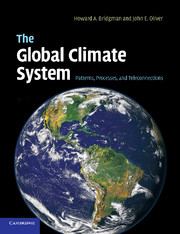Book contents
- Frontmatter
- Contents
- List of contributors
- Preface
- List of abbreviations
- 1 Introduction
- 2 Oscillations and teleconnections
- 3 Tropical climates
- 4 Middle-latitude climates
- 5 Climate of the polar realms
- 6 Post-glacial climatic change and variability
- 7 Urban impacts on climate
- 8 Human response to climate change
- 9 ESSAY: Model interpretation of climate signals: an application to Asian monsoon climate (Lau)
- 10 Conclusions and the future of climate research
- Other books on climatology and the climate system
- Index
- Plate section
- References
5 - Climate of the polar realms
Published online by Cambridge University Press: 05 June 2012
- Frontmatter
- Contents
- List of contributors
- Preface
- List of abbreviations
- 1 Introduction
- 2 Oscillations and teleconnections
- 3 Tropical climates
- 4 Middle-latitude climates
- 5 Climate of the polar realms
- 6 Post-glacial climatic change and variability
- 7 Urban impacts on climate
- 8 Human response to climate change
- 9 ESSAY: Model interpretation of climate signals: an application to Asian monsoon climate (Lau)
- 10 Conclusions and the future of climate research
- Other books on climatology and the climate system
- Index
- Plate section
- References
Summary
Introduction
The polar regions are defined as the areas north of the Arctic Circle and south of the Antarctic Circle. These regions represent the sinks in the global energy system of planet Earth. They have a number of common characteristics such as cold temperatures, ice covered oceans, glaciers and ice sheets. Both areas display an extreme seasonal variation in day length, with continuous daylight and darkness of up to six months. However, there are also large differences between the two regions, which are caused mainly by their geographic settings. In the Arctic there is a centrally located Arctic Ocean, which is surrounded by continents, while in Antarctica there is a centrally located continent, which is surrounded by oceans. Consequences of this are that Antarctica is covered by an ice sheet, and only some 2% of its area is ice free, while the only extensive ice sheet in the north can be found in Greenland. Owing to the high altitude of Antarctica – it has the highest mean elevation of all continents due to the snow and ice accumulation – the temperatures drop to very low values and in Vostok, a Russian inland station, a minimum temperature of − 89.5°C has been observed, the coldest temperature measured on Earth. This value is much lower than anything measured in the Arctic, where the coldest temperatures are found in Siberia. Sea ice is, on average, much thinner in the Southern Ocean, which at first glance might be surprising. […]
- Type
- Chapter
- Information
- The Global Climate SystemPatterns, Processes, and Teleconnections, pp. 131 - 170Publisher: Cambridge University PressPrint publication year: 2006
References
- 2
- Cited by

